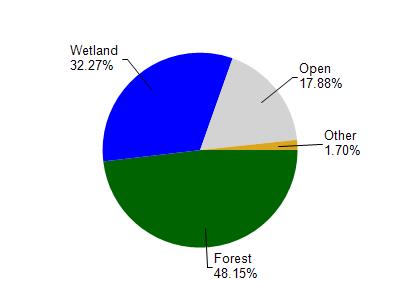Iron
No
No
No
Fish and Aquatic Life
Overview
West Randall Lake, in the Bear River Watershed, is a 9.02 acre lake that falls in Iron County. This lake is managed for fishing and swimming and is currently not considered impaired.
Date 2011
Author Aquatic Biologist
Historical Description
Source:1970, Surface Water Resources of Iron County,WI:WI-DNR West Randall Lake, T41N, R4E, Section 18 Surface Acres = 9.3, S.D.F. = 1.64, Maximum Depth = 10 feet A very soft water drained lake having acid, dark brown water of low transparency. The outlet stream does not afford any boating use and is tributary to Randall Creek and part of the Bear River drainage. The entire littoral zone is composed of muck. The entire shoreline is wetland of the bog and shrub type with some conifer. Information on the fishery is not available; however, largemouth bass and panfish are probably present. Waterfowl are expected to make limited use of this lake on their migrations. There are no developments located on the shoreline. Public access of the wilderness type is available over state controlled land. The entire lake is within the confines of state controlled lands (Division of Trust Lands and Investments), thus the entire shoreline of 0.7 mile is in public ownership.
Date 1970
Author Surface Water Inventory Of Wisconsin
Condition
Wisconsin has over 84,000 miles of streams, 15,000 lakes and milllions of acres of wetlands. Assessing the condition of this vast amount of water is challenging. The state's water monitoring program uses a media-based, cross-program approach to analyze water condition. An updated monitoring strategy (2015-2020) is now available. Compliance with Clean Water Act fishable, swimmable standards are located in the Executive Summary of Water Condition in 2018. See also the 'monitoring and projects' tab.
Reports
Management Goals
Wisconsin's Water Quality Standards provide qualitative and quantitative goals for waters that are protective of Fishable, Swimmable conditions [Learn more]. Waters that do not meet water quality standards are considered impaired and restoration actions are planned and carried out until the water is once again fishable and swimmable
Management goals can include creation or implementation of a Total Maximum Daily Load analysis, a Nine Key Element Plan, or other restoration work, education and outreach and more. If specific recommendations exist for this water, they will be displayed below online.
Monitoring
Monitoring the condition of a river, stream, or lake includes gathering physical, chemical, biological, and habitat data. Comprehensive studies often gather all these parameters in great detail, while lighter assessment events will involve sampling physical, chemical and biological data such as macroinvertebrates. Aquatic macroinvertebrates and fish communities integrate watershed or catchment condition, providing great insight into overall ecosystem health. Chemical and habitat parameters tell researchers more about human induced problems including contaminated runoff, point source dischargers, or habitat issues that foster or limit the potential of aquatic communities to thrive in a given area. Wisconsin's Water Monitoring Strategy was recenty updated.
Grants and Management Projects
Monitoring Projects
| WBIC | Official Waterbody Name | Station ID | Station Name | Earliest Fieldwork Date | Latest Fieldwork Date | View Station | View Data |
|---|
| 2318700 | West Randall Lake | 10002886 | West Randall Lake | 8/29/2000 | 8/7/2012 | Map | Data |
|

Watershed Characteristics
West Randall Lake is located in the Bear River watershed which is 145.45 mi². Land use in the watershed is primarily forest (48.20%), wetland (32.30%) and a mix of open (17.90%) and other uses (1.70%). This watershed has 109.53 stream miles, 16,823.52 lake acres and 30,671.84 wetland acres.
Nonpoint Source Characteristics
This watershed is ranked Not Ranked for runoff impacts on streams, Not Ranked for runoff impacts on lakes and Low for runoff impacts on groundwater and therefore has an overall rank of Low. This value can be used in ranking the watershed or individual waterbodies for grant funding under state and county programs.However, all waters are affected by diffuse pollutant sources regardless of initial water quality. Applications for specific runoff projects under state or county grant programs may be pursued. For more information, go to surface water program grants.